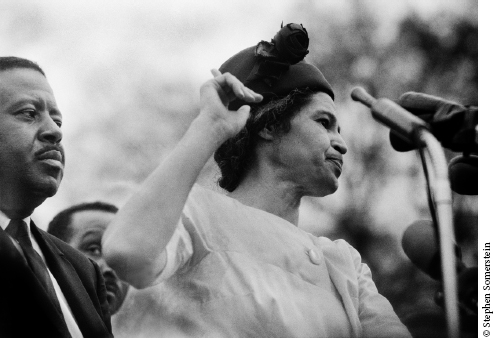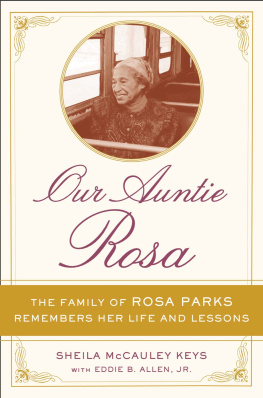
Rosa Parks speaking at the conclusion of the Selma to Montgomery civil rights march, 1965. Ralph Abernathy is on the left.

INTRODUCTION
National Honor/Public Mythology
The Passing of Rosa Parks
ON OCTOBER 24, 2005, AFTER nearly seventy years of activism, Rosa Parks died in her home in Detroit at the age of ninety-two. Within days of her death, Representative John Conyers Jr., who had employed Parks for twenty years in his Detroit office, introduced a resolution to have her body lie in honor in the Capitol rotunda. Less than two months after Hurricane Katrina and after years of partisan rancor over the social justice issues most pressing to civil rights activists like Parks, congressional leaders on both sides of the aisle rushed to pay tribute to the mother of the civil rights movement. Parks would become the first woman and second African American to be granted this honor. Awesome was how Willis Edwards, a longtime associate who helped organize the three-state tribute, described the numbers of the people who pulled it together.
Parkss body was first flown to Montgomery for a public viewing and service attended by various dignitaries, including Condoleezza Rice, who affirmed that without Mrs. Parks, I probably would not be standing here today as Secretary of State. Then her body was flown to Washington, D.C., on a plane commanded by Lou Freeman, one of the first African American chief pilots for a commercial airline. The plane circled Montgomery twice in honor of Parks, with Freeman singing We Shall Overcome over the loudspeaker. There wasnt a dry eye in the plane, recalled Parkss longtime friend, federal Sixth Circuit judge Damon Keith. Her coffin was met in Washington by the National Guard and accompanied to its place of honor in the Capitol rotunda.
Forty thousand Americans came to the Capitol to bear witness to her passing. President and Mrs. Bush laid a wreath on her unadorned cherrywood coffin. The Capitol Rotunda is one of Americas most powerful illustrations of the values of freedom and equality upon which our republic was founded, Senate majority leader Bill Frist, resolution cosponsor, explained to reporters, and allowing Mrs. Parks to lie in honor here is a testament to the impact of her life on both our nations history and future. Yet, Frist claimed Parkss stand was not an intentional attempt to change a nation, but a singular act aimed at restoring the dignity of the individual.
Her body was taken from the Capitol to the Metropolitan African Methodist Episcopal Church for a public memorial before an overflowing crowd. Then her casket was returned to Detroit for another public viewing at the Museum of African American History. Thousands waited in the rain to pay their respects to one of Detroits finest. The seven-hour funeral celebration held at Detroits Greater Grace Temple on November 2 attracted four thousand mourners and a parade of speakers and singers from Bill Clinton to Aretha Franklin. In their tributes, Democratic presidential hopefuls focused on Parkss quietness: Senator Barack Obama praised Parks as a small, quiet woman whose name will be remembered, while Senator Hillary Clinton spoke of the importance of quiet Rosa Parks moments. As thousands more waited outside to see the dramatic spectacle, a horse-drawn carriage carried Mrs. Parkss coffin to Woodlawn Cemetery, where she was buried next to her husband and mother.
Parkss passing presented an opportunity to honor a civil rights legend and to foreground the pivotal but not fully recognized work of movement women. Many sought to commemorate her commitment to racial justice and pay tribute to her courage and public service. Tens of thousands of Americans took off work and journeyed long distances to Montgomery, D.C., and Detroit to bear witness to her life and pay their respects. Across the nation, people erected alternate memorials to Mrs. Parks in homes, churches, auditoriums, and public spaces of their communities. The streets of Detroit were packed with people who, denied a place in the church, still wanted to honor her legacy. Awed by the numbers of people touched by Parkss passing, friends and colleagues saw this national honor as a way to lift up the legacy of this great race woman.
Despite those powerful visions and labors, the woman who emerged in the public tribute bore only a fuzzy resemblance to Rosa Louise Parks. Described by the New York Times as the accidental matriarch of the civil rights movement, the Rosa Parks who surfaced in the deluge of public commentary was, in nearly every account, characterized as quiet. Humble, dignified, and soft-spoken, she was not angry and never raised her voice. Her public contribution as the mother of the movement was repeatedly defined by one solitary act on the bus on a long-ago December day and linked to her quietness. Held up as a national heroine but stripped of her lifelong history of activism and anger at American injustice, the Parks who emerged was a self-sacrificing mother figure for a nation who would use her death for a ritual of national redemption. In this story, the civil rights movement demonstrated the power and resilience of American democracy. Birthed from the act of a simple Montgomery seamstress, a nonviolent struggle built by ordinary people had corrected the aberration of Southern racism without overthrowing the government or engaging in a bloody revolution.
This narrative of national redemption entailed rewriting the history of the black freedom struggle along with Parkss own rich political history disregarding her and others work in Montgomery that had tilled the ground for decades for a mass movement to flower following her 1955 bus stand. It ignored her forty years of political work in Detroit after the boycott, as well as the substance of her political philosophy, a philosophy that had commonalties with Malcolm X, Queen Mother Moore, and Ella Baker, as well as Martin Luther King Jr. The 2005 memorial celebrated Parks the individual rather than a community coming together in struggle. Reduced to one act of conscience made obvious, the long history of activism that laid the groundwork for her decision, the immense risk of her bus stand, and her labors over the 382-day boycott went largely unheralded, the happy ending replayed over and over. Her sacrifice and lifetime of political service were largely backgrounded.
Buses were crucial to the pageantry of the event and trailed her coffin around the country. Sixty Parks family members and dignitaries traveled from Montgomery to D.C. aboard three Metro buses draped in black bunting. In D.C., a vintage bus also dressed in black, along with other city buses, followed the hearse to the public memorial at the Metropolitan African Methodist Episcopal Church. The procession to and from the Capitol rotunda included an empty vintage 1957 bus. The Henry Ford Museum in Dearborn, Michigan, offered free admission the day of her funeral so visitors could see the actual bus where it all began.
Parkss body also served an important function, brought from Detroit to Montgomery to Washington, D.C., and then back to Detroit for everyone to witness. Her body became necessary for these public rites, a sort of public communion where Americans would visit her coffin and be sanctified. This personal moment with Parkss body became not simply a private moment of grief and honor but also a public act of celebrating a nation that would celebrate her. Having her casket on view in the Capitol honored Parks as a national dignitary while reminding mourners that their experience was sponsored by the federal government. Look how far the nation has come, the events tacitly announced, look at what a great nation we are. A woman who had been denied a seat on the bus fifty years earlier was now lying in the Capitol. Instead of using the opportunity to illuminate and address current social inequity, the public spectacle provided an opportunity for the nation to lay to rest a national heroine













